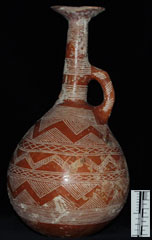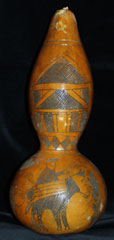| Visiting | Features | The Collections |
Services | Online Resources |
More Resources |
SiteMap |
 |
Ashmolean Museum of Art and Archaeology |
|
|
| Presentations | |||
| Ancient
Cyprus in the Ashmolean Museum |
| Visiting | Features | The Collections |
Services | Online Resources |
More Resources |
SiteMap |
 |
Ashmolean Museum of Art and Archaeology |
|
|
| Presentations | |||
| Ancient
Cyprus in the Ashmolean Museum |
| Highlights of the Collection: Prehistoric Terracottas | |||
| Red Polished and Black Polished ware | Page 5 of 9 | ||
| Red Polished ware, along with its twin Black Polished, is the most characteristic ware of the Cypriot Early Bronze Age, spanning a period of something like six hundred years. As its name suggests, Red Polished is distinguished by a dark red-brown surface slip, whose colour derives from oxidising conditions during firing, and which is sometimes (though not always) highly polished. Its counterpart, Black Polished, is basically the same ware, on which the slip is subjected to reducing conditions during firing, thus turning the surface black. Both techniques are sometimes found in combination on the same pot [e.g. dagger (AN1974.355)]. |  |
|||
| Dagger
& Sheath (AN1974.355) |
||||
 |
Both wares encompass a wide range of shapes, including flasks, jugs and bowls of various types and sizes, most of them with rounded bases. Many of the flasks and jugs have long spindly necks perched on bulbous bodies, and look rather gourd-like [e.g. "Gourd" jug (AN1953.255), left]. Real dried gourds, with incised decoration, and reminiscent of the shapes and appearance of Red Polished pottery, can still be bought in Cypriot tourist shops today [see Modern Gourd, right]. They are often decorated with incised patterns which were filled with a white calcareous substance to make them stand out. |  |
|
| "Gourd"
jug (AN1953.255) |
Modern
Gourd |
||
| Previous
Page (Cypriot pottery and clay figurines 3) |
Introduction
to Prehistoric Terracottas |
Next
Page (White Painted ware) |
|
| Ancient Cyprus Home | Top of Page |
© Copyright University of Oxford, Ashmolean Museum, 2004 The Ashmolean Museum retains the copyright of all materials used here and in its Museum Web pages. Last updated: 22-sep-2004 |
|
HomePage | Visiting
| Features
| The Collections Services | Online Resources | More Resources | SiteMap | Top of Page |